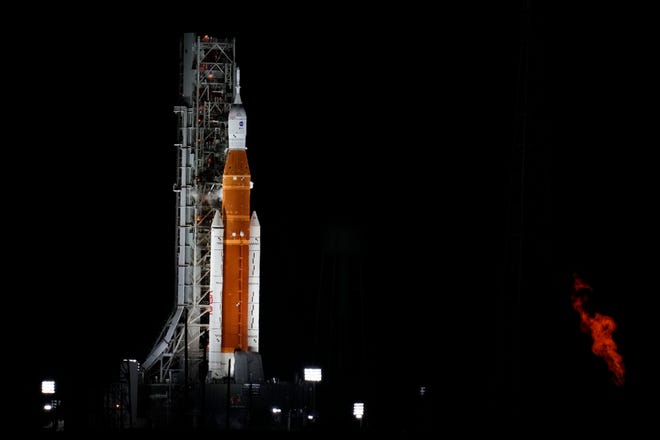NASA’s Artemis I mission, scheduled to launch Monday to take an Orion capsule with three test dummies to the moon and back, was scrubbed because of an engine cooling issue and other concerns that cropped up during final preparations.
The next flight window from Florida’s Kennedy Space Center is Friday if NASA determines the rocket is ready, which is far from certain.
“Friday is definitely in play,” said mission manager Mike Sarafin. “We just need a little bit of time to look at the data, but the team is setting up for a 96-hour recycle.”
Sarafin said signs don’t point to a problem with the engine, but rather with the bleed system that keeps the engines at the proper temperature. And he revealed that weather concerns during the window of time for launch were also part of the decision to scrub.
“We would have been a no-go for weather at the beginning of the window due to precipitation,” Sarafin said. “And later on in the window, we would have been no-go for lightning within the launch pad area.”
This will be the first flight in NASA’s Artemis project, a quest to put astronauts back on the moon for the first time since the Apollo program ended 50 years ago. The timeline for returning to the moon is sometime after 2025. This first test mission involves a roundtrip that will take about 42 days.
Amid the disappointment about the delay on a day when Vice President Kamala Harris was in attendance, NASA Administrator Bill Nelson tried to put the decision in perspective, noting that his spaceflight was scrubbed four times before he became the second member of Congress to reach Earth’s orbit, in 1985.
“Scrubs are just part of this program,” he said.
Added Jim Free, NASA’s Associate Administrator for Exploration Systems Development, citing the advice Deputy Administrator Pamela Melroy shared with her family when they were coming to watch her own spaceflight take off: “Plan a week trip to Florida for vacation and you might see a launch.”
NASA had struggled to fuel the rocket with nearly 1 million gallons of hydrogen and oxygen because of a leak of highly explosive hydrogen, a problem that also flared up during testing last spring.
The massive Space Launch System rocket will become the agency’s most powerful when it ultimately takes flight. The top priority will be testing Orion’s new heat shield as it reenters Earth’s atmosphere at 25,000 mph. The capsule will have to survive the fiery descent during the process that will likely become one of the fastest reentries to date.
50 YEARS LATER: US takes its first step back to moon with launch of Artemis I
VP Kamala Harris reaffirms commitment to space exploration
Vice President Kamala Harris was among thousands who gathered in Florida for the launch. She remained upbeat after the decision was made to postpone the flight.
“While we hoped to see the launch of Artemis I today, the attempt provided valuable data as we test the most powerful rocket in history,” Harris tweeted. “Our commitment to the Artemis Program remains firm, and we will return to the moon.”
NASA: ‘You don’t want to light the candle until it’s ready to go’
The postponement was a disappointment to thousands of people who jammed the Florida coastline to see the launch. Launch commentator Derrol Nail said engineers were still analyzing the issues, and “we must wait to see what shakes out from their test data” before announcing a new launch date and time. NASA Administrator Bill Nelson said delays are part of the “space business,” particularly when dealing with machines as complicated as Artemis 1.
“All those things have to work, and you don’t want to light the candle until it’s ready to go,” he said.
NASA announces postponement, no word yet on next try
NASA said launch director Charlie Blackwell-Thompson halted the launch attempt at 8:34 a.m. The Space Launch System rocket and Orion spacecraft “remain in a safe and stable configuration,” NASA said in a statement.
Launch controllers were continuing to evaluate why a bleed test to get the engines on the bottom of the core stage to the proper temperature range for liftoff was not successful, and they ran out of time because of the two-hour launch window. Engineers were continuing to gather data.
NASA announces ‘unplanned hold’
NASA tweeted that the launch was on hold: “#Artemis I update: Launch is currently in an unplanned hold as the team works on an issue with engine number 3 on the @NASA_SLS core stage. Operations commentary continues at http://nasa.gov/live.”
Fuel leaks threaten to force postponement
Fuel leaks during final liftoff preparations threatened to postpone the launch. NASA repeatedly stopped and started the fueling of the Space Launch System rocket with nearly 1 million gallons of super-cold hydrogen and oxygen because of a leak. The fueling already was running nearly an hour late because of thunderstorms near Florida’s Kennedy Space Center.
The leak of highly explosive hydrogen appeared in the same place that saw seepage during a dress rehearsal in the spring.
Then a second apparent hydrogen leak turned up in a valve that had caused trouble in June but that NASA thought it had fixed, officials said.
Rocket is most powerful to fly from ‘Space Coast’ in decades
NASA’s Space Launch System rocket is a behemoth. It is more powerful than rockets that have flown from Florida’s Space Coast in decades. An orange core stage, flanked by bright white solid rocket boosters, helps make it visually unique. And its height is imposing at 322 feet – about the same as 30-story building.
At least 100,000 visitors are expected to crowd areas around Kennedy Space Center for the mission. In the event of a delay, two backup opportunities – Sept. 2 at 12:48 p.m. and Sept. 5 at 5:12 p.m. EDT – are available.
Contributing: Jamie Groh and Craig Bailey, Florida Today; The Associated Press

















Discussion about this post